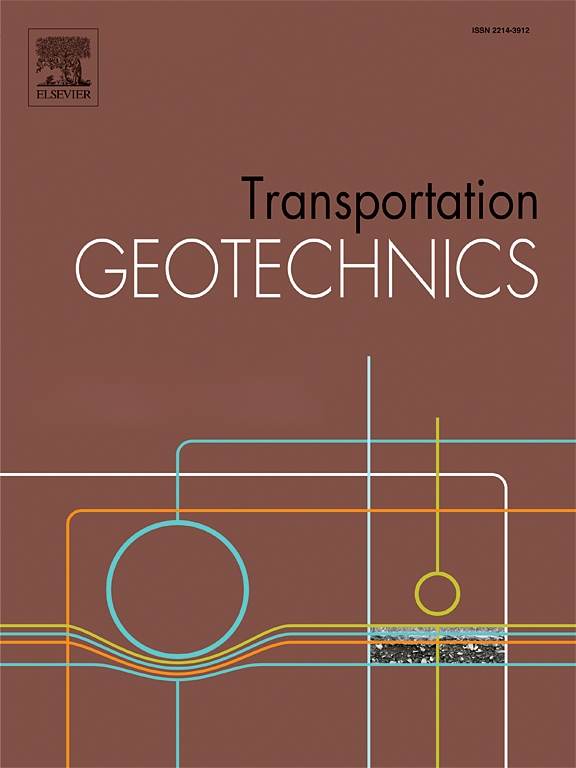Saturated and unsaturated properties of recycled concrete aggregate for sustainable pavement design
IF 5.5
2区 工程技术
Q1 ENGINEERING, CIVIL
引用次数: 0
Abstract
Pavement base layers are constructed to specified quality standard to distribute traffic loads and drain excess water from the pavement structure. The use of recycled concrete aggregates (RCAs) as base material has become increasingly common due to their mechanical properties and sustainability benefits. However, poor drainage and the presence of unhydrated cement in RCAs can lead to pavement saturation, adversely affecting their performance. Therefore, it is essential to thoroughly evaluate the physical, mechanical, and hydraulic properties that may impact the pavements’ performance. In this research, twelve RCA base materials, including three Open-Graded Drainage Courses (OGDC), a blended mix, and five natural aggregates (GMs) were evaluated for index properties, hydraulic properties, and stiffness (resilient modulus, MR). Using the FHWA Drainage Requirement in Pavements (DRIP) software and the laboratory test results, the time required to drain 50 % of the saturated layer was also evaluate. The GMs, with MR ranging from 114 to 513 MPa, had higher density but exhibited “poor” to “very poor” drainage quality. In contrast, the coarse gradation of RCAs, with MR varying from 162 to 730 MPa, led to higher stiffness and better drainage. However, coarse RCAs exhibited 4 to 6 times higher moisture absorption, while the sand fraction had 3 to 5 times higher absorption, causing RCAs to retain moisture longer than GMs. No material exhibited “excellent” drainage quality, not even the OGDCs. Furthermore, increasing the layer thickness had minimal impact on improving drainage quality, highlighting the importance of considering alternative pavement drainage solutions for effective pavement drainage.
可持续路面设计中再生混凝土骨料的饱和和不饱和特性
路面基层按规定的质量标准施工,以分散交通荷载并排出路面结构中的多余水分。再生混凝土骨料(RCAs)由于其机械性能和可持续性效益,作为基础材料的使用越来越普遍。然而,rca中排水不良和未水化水泥的存在会导致路面饱和,对其性能产生不利影响。因此,全面评估可能影响路面性能的物理、机械和水力性能是必要的。在这项研究中,研究人员评估了12种RCA基材,包括3种开放分级排水层(OGDC)、一种混合料和5种天然骨料(GMs)的指标性能、水力性能和刚度(弹性模量,MR)。利用FHWA的路面排水要求(DRIP)软件和实验室测试结果,还评估了排水50%饱和层所需的时间。MR值为114 ~ 513 MPa的GMs密度较高,但排水质量“差”至“极差”。相比之下,粗级配的RCAs (MR范围为162 ~ 730 MPa)具有更高的刚度和更好的排水性。然而,粗粒RCAs的吸湿性是粗粒RCAs的4 ~ 6倍,而砂粒RCAs的吸湿性是粗粒RCAs的3 ~ 5倍,这使得RCAs比粗粒RCAs保持水分的时间更长。没有材料表现出“优秀”的排水质量,即使是ogdc。此外,增加层厚对改善排水质量的影响最小,这突出了考虑替代路面排水解决方案以实现有效路面排水的重要性。
本文章由计算机程序翻译,如有差异,请以英文原文为准。
求助全文
约1分钟内获得全文
求助全文
来源期刊

Transportation Geotechnics
Social Sciences-Transportation
CiteScore
8.10
自引率
11.30%
发文量
194
审稿时长
51 days
期刊介绍:
Transportation Geotechnics is a journal dedicated to publishing high-quality, theoretical, and applied papers that cover all facets of geotechnics for transportation infrastructure such as roads, highways, railways, underground railways, airfields, and waterways. The journal places a special emphasis on case studies that present original work relevant to the sustainable construction of transportation infrastructure. The scope of topics it addresses includes the geotechnical properties of geomaterials for sustainable and rational design and construction, the behavior of compacted and stabilized geomaterials, the use of geosynthetics and reinforcement in constructed layers and interlayers, ground improvement and slope stability for transportation infrastructures, compaction technology and management, maintenance technology, the impact of climate, embankments for highways and high-speed trains, transition zones, dredging, underwater geotechnics for infrastructure purposes, and the modeling of multi-layered structures and supporting ground under dynamic and repeated loads.
 求助内容:
求助内容: 应助结果提醒方式:
应助结果提醒方式:


